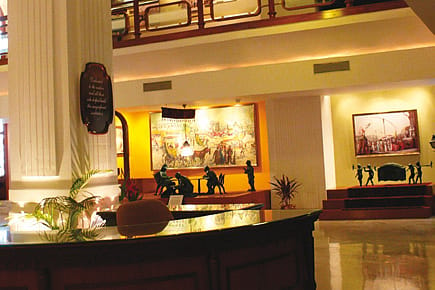Where You Can See Tagore’s Passbook

The State Bank museum in Kolkata also boasts Rajendra Prasad's current account application and the box that stored Gandhi's ashes
This could well be a case of discrimination of a different kind. If a European officer working with the Bank of Bengal wanted to get married in the late 1800s, he had to please more than the girl and her parents. One of the bank's service rules of 1899 stipulated a minimum salary of Rs 700 per month as eligibility for marriage. Indian employees in service with the bank, however, didn't have specific rules and service conditions until much later.
Indians were discriminated against, too, but in a more predictable manner. Take the 1889 case of Kidderpore's Potit Pabun Mitra, who complained about TWL Bruce, a junior European officer, for 'alleged rudeness and an enquiry into the same'. The written complaint was lodged in a register maintained by the Bank of Bengal, which also has an account of the officer's explanation: 'I have no recollection, whatever, of the occurrence, and most emphatically decline to apologise in any way to this exceedingly underbred person. His letter is composed of insulting sentences, and my only regret in the matter is that his age alone prevents my taking notice of the occurrence.'
2026 New Year Issue
Essays by Shashi Tharoor, Sumana Roy, Ram Madhav, Swapan Dasgupta, Carlo Pizzati, Manjari Chaturvedi, TCA Raghavan, Vinita Dawra Nangia, Rami Niranjan Desai, Shylashri Shankar, Roderick Matthews, Suvir Saran
These are just a few of the 15,000 records archived at the State Bank Archives and Museum at Strand Road in Kolkata. Opened to the public in May 2007, the archives marked 200 years of State Bank of India's existence and cost nearly Rs 1.5 crore. It was the merging of the first three banks in India—Bank of Calcutta, founded in 1806 (later Bank of Bengal), Bank of Bombay (1840) and Bank of Madras (1843)—that went on to become the Imperial Bank of India in 1921. The bank was nationalised in 1955 and renamed State Bank of India (SBI).
But surely, even the bank's top management team, which conceived of the idea 10 years before the bicentenary, would not have expected the treasure trove they would unearth as the bank reached out to its oldest branches and their strong rooms. Out came hand-written passbooks of Annie Besant, Rabindranath Tagore, Dadabhai Naoroji, Jamsetjee Jeejebhoy and JRD Tata, to name the most prominent. Current account applications by Dr Rajendra Prasad, Liaquat Ali Khan, Hidayatullah Khan were discovered, as was a 0.32 automatic Webley and Scott pistol in a Kozhikode branch. And then, there was an urn said to contain Mahatma Gandhi's ashes, which had been kept for safekeeping at the Cuttack branch. Apparently, Gandhi's ashes had been sent to all state capitals for people to pay their homage. For some unexplained reason, those in Odisha were never returned until 1996, when the Mahatma's grandson Tushar Gandhi laid claim to it. The wooden box that stored the ashes is now in the museum.
Interestingly, though the Bank of Hindostan (1770) was the first to introduce paper money in India, it was the bank notes between Rs 10 and Rs 10,000 that were issued by the three banks (Bank of Bengal, Bank of Bombay and Bank of Madras) which were accepted as legal tender for public revenue payments. The archivists and curators make sure you don't miss the then Governor General of India Lord William Bentinck's bust and recount how the Bank of Bengal once returned his cheque since it 'proved to be four annas beyond the sum of his credit'.
The most interesting thing about the museum, however, is that it houses the history of banking in India since 1806 in a 7,200 sq ft area. It is also the only such banking archives museum in India. Sculptures depict shresthis or shroffs (bankers) financing eager European merchants. There are accounts of how the applicable rate of interest varied by the nature of the transaction as well as caste of the borrower: while Brahmins had to pay 24 per cent, and Kshatriyas and Vaishyas 36 and 48 per cent, respectively, Shudras had to pay a whopping interest rate of 60 per cent. This was an ancient assumption of credit worthiness based on assumed differences in the 'nature' of castes.
Also on display are rare bank notes, bank seals, balance sheets, leaflets and journals, and even remnants of the first Bank of Bengal building—a stained glass door, wrought iron fireplace, Italian tiles, a 150-year-old door frame and swords held in sheaths by the guards on duty.
Plans are on to convert the analogue records into digital so that they can be accessed online. But the archivists say the move may take up to a year. Meanwhile, all SBI branches that are 100 years old will have their own heritage gallery and mark the bank's 200-year heritage.
